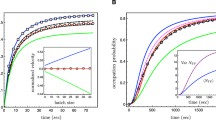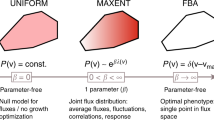Abstract
Schemes are presented for induced synthesis of the dissociable enzyme in which repeated use of the template is made. The role of the inducer is to release the repression. A mathematical analysis is carried out and expressions are obtained to describe the kinetics of enzyme formation. A practical case (penicillinase synthesis) is compared with theoretically derived equations by using an analogue computer to simulate an enzyme forming system. A good correlation between theoretical and experimental data is obtained.
Similar content being viewed by others
Literature
Cohn, M. 1957. “Contributions of the Studies of the β-Galactosidase ofEscherichia coli to Our Understanding of Enzyme Synthesis”.Bacteriol. Rev.,21, 140.
Creaser, E. H. 1956. “The Assimilation of Amino Acids by Bacteria”.Biochem. J.,64, 539.
Gorini L. 1960. “Antagonism between Substrate and Repressor in Controlling the Formation of a Biosynthetic Enzyme”.Proc. Nat. Acad. Sci.,46, 682.
Heinmets, F., and A. Herschman. 1960. “Quantitative Analysis of Metabolic Processes”.Phys. Med. and Biol.,4, 238.
— 1961. “Quantitative Analysis of Metabolic Processes. III”.Bull. Math. Biophysics,23, 69–89.
Jackson, A. S. 1960.Analogue Computers. New York: McGraw-Hill.
Monod, J. 1956. InEnzymes: Units of Biological Structure and Function, p. 7. New York: The Academic Press, Inc.
Neidhardt, F. C., and B. Magasinik. 1956. “The Effect of Glucose on the Induced Biosynthesis of Bacterial Enzymes in the Presence and Absence of Inducing Agents”.Biochim. Biophys Acta,21, 324.
Pardee, A. B. 1954. “Nucleic Acid Precursors and Protein Synthesis”.Nat. Acad. Sci.,40, 263.
— 1957. “An Inducible Mechanism for Accumulation of Melibiose inEscherichia coli”.J. Bact.,73, 376.
— 1959. InThe Enzymes, pp. 681. New York: The Academic Press.
Pardee, B., F. Jacob, and J. Monod. 1958. “Génétique Biochimique.”Compte rendu,246, 3125.
Pollock, M. R. 1950. “Penicillinase Adaptation inBacillus Cereus: Adaptative Enzyme Formation in the Absence of Free Substrate”.Brit. J. Exptl. Pathol.,31, 739.
— 1952. “Penicillinase Adaptation inBacillus cereus: An Analysis of Three Phases in the Response of Logarithmically Growing Cultures to Induction of Penicillinase Formation by Penicillin”.Brit. J. Exptl. Pathol.,33, 587.
— 1959. InThe Enzymes, p. 619. New York: The Academic Press.
Pollock, M. R., and C. J. Perret. 1951. “The Relation between Fixation of Penicillin Sulfur and Penicillinase Adaptation inBacillus cereus”.Brit. J. Exptl. Pathol.,32, 387.
Rickenberg, H. V., Ch. Yanofsky, and D. M. Bonner. 1953. “Enzymatic Deadaption”.J. Bact.,66, 683.
Spiegelman, S., H. O. Halvorson, and R. Ben-Ishai. 1955. “Free Amino Acids and the Enzyme-forming Mechanism”. InSymposium on Amino Acid Metabolism, p. 124. Baltimore: Johns Hopkins Press.
Umbarger, H. E., and B. Brown. 1958. “Isoleucine and Valine”.J. Biol. Chem.,233, 415.
Vogel, H. J. 1957. “Repressed and Induced Enzyme Formation: A Unified Hypothesis”.Proc. Nat., Acad. Sci.,43, 491.
Yates, R. N., and A. B. Pardee. 1956. “Control of Pyrimidine Biosynthesis inEscherichia coli by a Feedback Mechanism”.J. Biochem.,221, 757.
Author information
Authors and Affiliations
Rights and permissions
About this article
Cite this article
Heinmets, F., Herschman, A. Quantitative analysis of metabolic processes. II. A model-system for the synthesis of the dissociable enzyme and mathematical formulation of the process. Bulletin of Mathematical Biophysics 23, 277–295 (1961). https://doi.org/10.1007/BF02476741
Received:
Issue Date:
DOI: https://doi.org/10.1007/BF02476741




